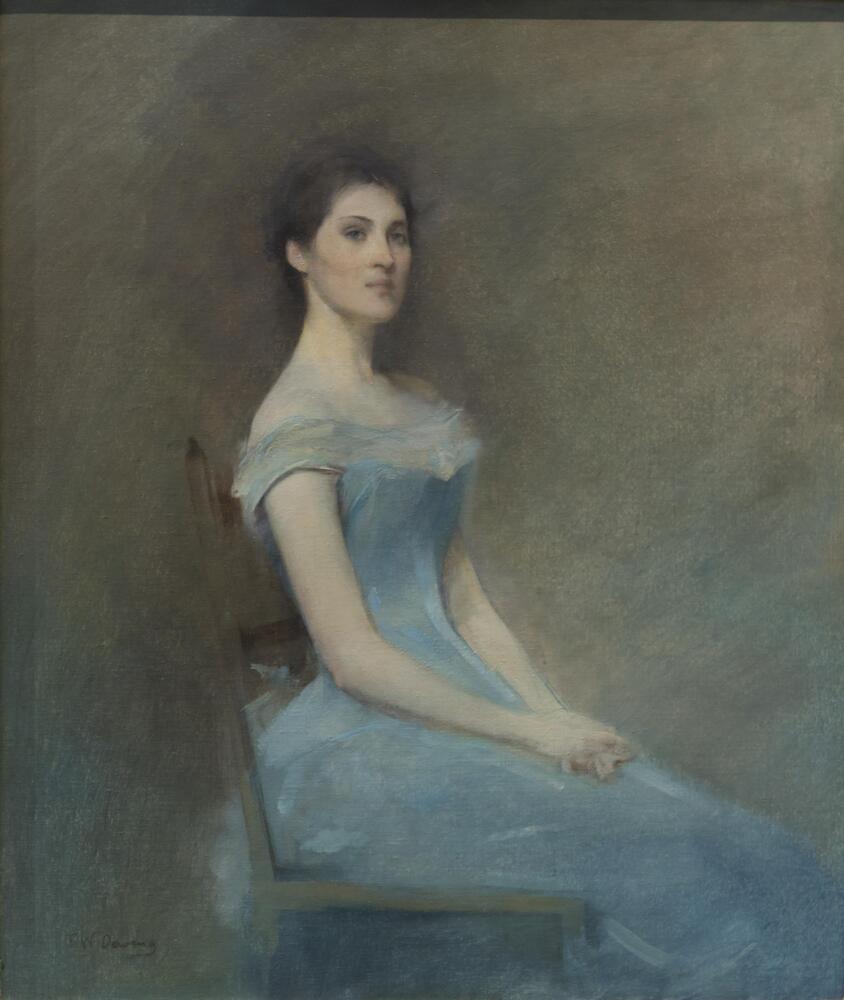Essay: Dewing
Artist
Thomas Wilmer Dewing was born in 1851 to a middle-class family in the suburbs of Boston at a time when American art was still dependent on European convention. He went abroad to study at the Académie Julian in Paris where he learned the techniques of the great masters including anatomy, classical modeling of form, compositional structure, and correct color tonality and balance. He was also, however, associated with vanguard, forward-looking movements and both his classical training and contemporary interests may be seen in his portraiture.
Dewing was a Tonalist, and, more broadly, part of the Aesthetic Movement which followed the credo of “art for art’s sake,” embracing taste, beauty, and self-expression over moral expectations. Tonalists such as Dewing and James McNeill Whistler, also represented in UMMA’s collection, privilege the qualities inherent in the media, and feature soft, muted colors that could be described as musical or harmonic.
Object Information: Dewing’s Women and Miss Minnie Clark
Dewing’s portraits of finely dressed, women, often anonymous, situated against sparse, mysteriously empty backgrounds are considered his trademark. Figure of a Girl in Blue follows this pattern, yet it is unusual in that we know the subject. The sitter is Minnie Clark, an Irish immigrant and working-class model who was, despite her humble background, one of the many models of the “Gibson Girl” a figure who represented beauty and class. Clark was a successful model during the late nineteenth century, known for her distinctive, pronounced features such as high cheekbones and trademark dark hair. Although a known and named model, this painting is characteristic of Dewing’s portraits of women set in empty backgrounds which often possess Whistleresque titles about color or music.
In this painting, Dewing melds his academic training with the musical, impressionistic style of Tonalism. Clark sits in a traditional three-quarter portrait pose situated against a hazy, soft blank background. The strict composition of academicism is juxtaposed with the new, painterly aesthetic. This dichotomy is also present in Dewing’s treatment of the subject. Dewing has emphasized Clark’s strong features by painting them with a clean line and attention to color. Her face is defined, sharp in contrast to the haziness of her dress and body. In this combination of his French training and contemporary influence, Dewing creates a dialogue between tradition and modernism.
Themes and Ideas for Teaching
- What aspects of Figure of a Girl in Blue make you think of Impressionism?
- Think about other works in UMMA’s collection that have a relationship to Charles Lang Freer (for example, Whistler’s Sea and Rain: Variations on Violet and Green). Do you see a common theme that ties them together? Is it in technique or subject matter?
- Dewing didn’t have access to fine arts education by virtue of being an American and thus had to study his craft in Europe. What about this piece is reminiscent of contemporary European works (such as Monet’s Breakup of the Ice)? Is there anything in it that is more suggestive of previous conventions?
Sources
“American Tonalism: Selections from The Metropolitan Museum of Art and The
Montclair Art Museum.” Monclair Art Museum. Accessed Feb 1, 2018. http://www.tfaoi.com/newsm1/n1m555.htm
Anderson, Ross C. “Dewing, Thomas Wilmer” Grove Art Online. Oxford University Press, 04 February 2008, http://groveart.com.
Freer Gallery of Art. Freer Gallery of Art. Washington, D.C.: Smithsonian Institution, 1983.
Hobbs, Susan. The Art of Thomas Wilmer Dewing: Beauty Reconfigured. Washington, D.C.: Smithsonian Institution Press, 1996.
Merrill, Linda, ed. With Kindest Regards: The Correspondence of Charles Lang Free and James McNeill Whistler 1890-1903. Washington, D.C.: Smithsonian Institution, 1995.
“Thomas Wilmer Dewing.” Smithsonian American Art Museum. Accessed Feb 1, 2018.
https://americanart.si.edu/artist/thomas-wilmer-dewing-1247
Van Hook, Bailey. A Mural by Thomas Wilmer Dewing: Commerce and Agriculture Bringing Wealth to Detroit. New York, NY: Spanierman Gallery, LLC, 1998.
Jane Braun (2008)
Eva Caston (2018)
Created For
K-12 EducatorK-12 Student
Museum Visitor
UMMA Docent
UMMA Staff
University Faculty
University Student
Rate this Resource
AVG: 0 | Ratings: 0
& Author Notes
Creative Commons by-nc-saLast Updated
May 1, 2018 10:46 a.m.Report
Reporting Policy

